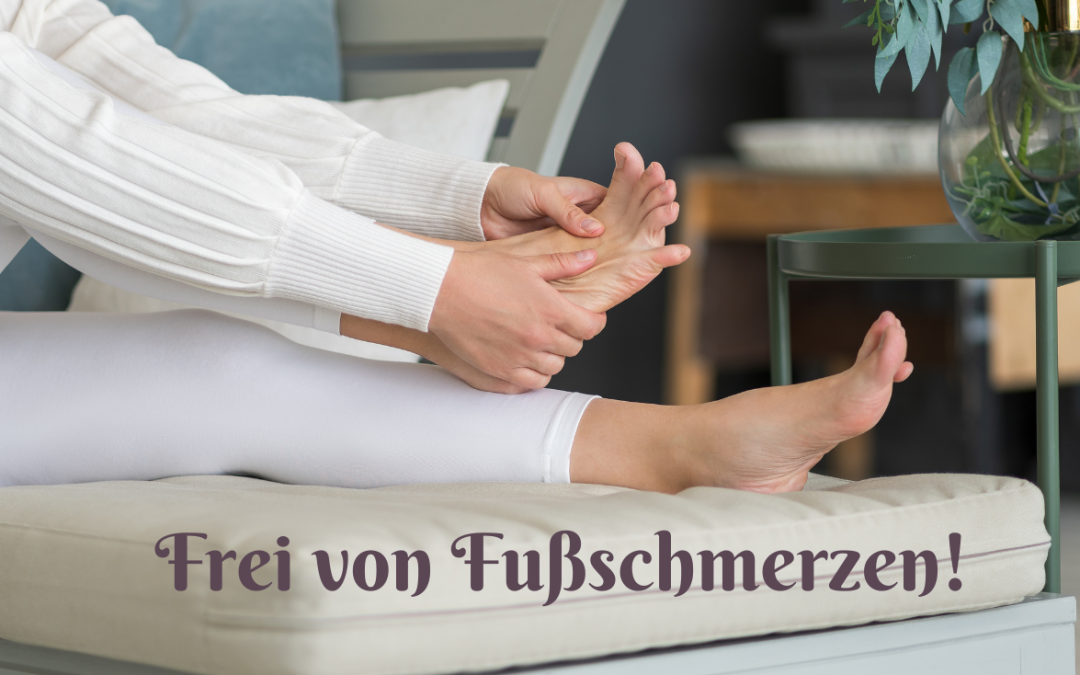Pain and restricted movement in the feet can severely restrict our everyday lives. I was able to experience this for myself several times as an athlete.
In the case of foot problems, a distinction is made between acute injuries and chronic symptoms. All the nerves in the body end under the sole of the foot, which makes it particularly sensitive. The ancient peoples already knew this and developed a beneficial foot reflexology therapy to treat the organs of the body via the feet. Massaging an organ zone on the feet can have an immediate effect. A healing impulse is sent via the nerves to the affected organ, which, depending on the stimulation, can make itself felt immediately. As a child, I experienced this positive effect several times when my mother healed my stomach ache with her feet while I was sitting on the edge of my bed in the evening.
But what are the underlying causes of long-lasting pain in the feet? Here we should differentiate and investigate more deeply at which level the symptoms lie. A mechanical problem usually manifests itself in pressure points and misalignments (e.g. hallux valgus).
The causes are not directly in the foot itself, but in the way of walking and the body statics. We can visualize again and again that the feet are “only” attached to the leg. The decision about our “final appearance” is decided primarily in the hips, which in most people do not move freely when walking and running. The result is a widespread hard heel strike. In addition, the toes are often compressed in shoes that are too tight, resulting in an arched foot. This can lead to hallux valgus later on.
In the advanced stage, rolling does not take place via the outer instep of the foot, but via the inner edge, which is overstretched with every step. This can lead to inflammation in the long term. The hallux valgus serves as an “internal support” for the foot – similar to a bicycle stand – which tries to balance the statics so that “the wheel” (the person) does not fall over.
[youtube https://www.youtube.com/watch?v=0I94f-DLjHY&w=560&h=315]
Correcting the body’s statics is useful for curing mechanical foot problems. Immobile insoles can only be an acute solution here, as they cannot bring about a longer-term correction. Only the moving body itself can do this.
We have developed the Tarasolesgrounding sandals to help you switch to a healthy gait.
Pain and restricted movement in the feet can often be caused by metabolism. The typical symptoms that indicate this are usually
- Burning and chronic pain on and under the feet
- Skin lesions, cracks, blisters (including itching)
- Discolorations
- Deposits (e.g. in the case of a chronic heel spur)
- Neurological symptoms (numbness, stiffness, shooting pain)
Conventional medical diagnostics quickly reach their limits when it comes to foot pain. Often a conventional diagnosis cannot provide any precise information about the real cause of the problem. The therapies prescribed as a result therefore usually ignore the underlying causes. For this reason, many foot problems are classified as psychosomatic. Which means that the cause is psychological and stress-related. I often receive emails from people who write to me that they have experienced pain for the first time after a life crisis. Whenever stress comes into our lives (which is inevitably often the case in this world), adrenaline is released. Depending on the stress situation, different hormone mixtures are released. Important processes are set in motion for our survival, e.g. an escape impulse is initiated. But how can prolonged stress cause chronic foot problems?
Even if medical research has not yet sufficiently investigated this, viruses and bacteria are involved in a large number of inflammations. These can cause redness, swelling, inflammation and even neurological processes, particularly on the feet. Viruses in particular can be an undetected cause of pain. The Epstein Barr virus (Pfeiffer virus) can not only cause acute sore throats, but can also migrate deeper into the organism at a later stage and persist there for decades. The virus hides in the organs and waits for food. Viruses prefer gluten-containing carbohydrates, animal proteins, refined sugars as well as toxins such as heavy metals and pesticides as their food sources. It is not known that viruses particularly like to feed on adrenaline, which, as already described, is released during stress. However, not all grief inevitably results in chronic symptoms. Only when viruses such as herpes and Epstein-Barr viruses or other subspecies are present in the organism do chronic diseases find an optimal environment. Incidentally, viruses’ best friends are bacteria (such as streptococci), which can trigger acute inflammation of the musculoskeletal system. Athlete’s foot can also indicate a chronic viral load. Once the body’s environment is contaminated with “hidden roommates”, this can trigger a long history of suffering. Viruses are scavenging pathogens – which was previously unknown. They particularly like to nibble on the fine nerve endings and thus cause neurological symptoms. Later, satiated, they retreat into the nerve cells and sleep there like kittens in front of a warm stove. Until they wake up hungry again and can trigger the next pain attack!
For this reason, targeted body cleansing is absolutely essential for chronic foot pain. Not only should the diet be changed, but heavy metals, viruses and bacteria should be “drained” from the organism as a whole. These hidden pathogens can only be “killed off” if their food is removed first. Virus-friendly foods should be avoided. Food supplements also help to change the environment so that unwanted roommates no longer feel welcome in the long term. Heavy metals should be “detoxed” at the same time. These tend to accumulate on the soles of the feet in particular, which “magically attracts” viruses and bacteria.

